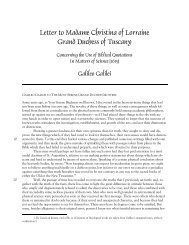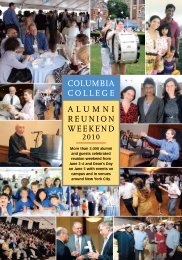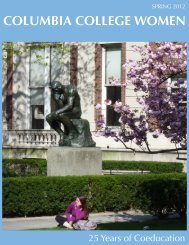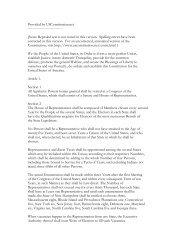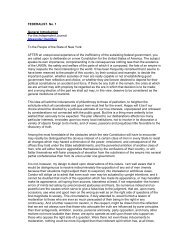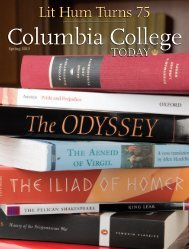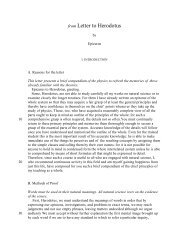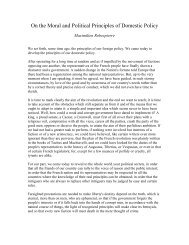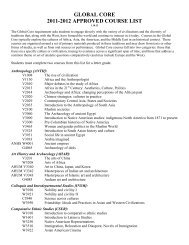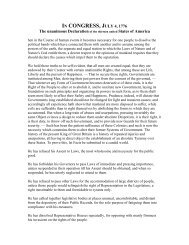A Passion for Science - Columbia College - Columbia University
A Passion for Science - Columbia College - Columbia University
A Passion for Science - Columbia College - Columbia University
Create successful ePaper yourself
Turn your PDF publications into a flip-book with our unique Google optimized e-Paper software.
<strong>Columbia</strong> CollEgE Today BOOKShELF<br />
A Serious look at The Joker and His Creator<br />
Jerry Robinson, who attended the <strong>College</strong> in<br />
the early 1940s, decided to go to <strong>Columbia</strong><br />
after he was offered a job illustrating a new<br />
comic book called Batman.<br />
N.C. Christopher Couch ’76, ’87 GSAS took a<br />
more conventional route. “When I visited the campus<br />
with my family, I knew instantly it was where I<br />
wanted to be,” he says.<br />
More than 30 years separated their time at the<br />
<strong>University</strong>, but a love of comic books brought them<br />
together, first as friends, then as collaborators on<br />
Jerry Robinson: Ambassador of Comics (Abrams<br />
Comic Arts, $35). The book charts Robinson’s life,<br />
from his boyhood in Trenton, N.J., in the 1920s and<br />
’30s to his appearances at Comic-Con conventions,<br />
where he is treated as a mythic figure in comic book<br />
history.<br />
Couch, who teaches courses on comic art and the<br />
graphic novel in the Program in Comparative Literature<br />
at <strong>University</strong> of Massachusetts Amherst, conducted<br />
more than 50 hours of interviews with Robinson, now<br />
89, to write the book. “I just set down the tape recorder<br />
and asked, ‘What would you like to talk about today?’ ”<br />
Couch says.<br />
Some of the stories Robinson told, such as how he<br />
landed the Batman gig, are the stuff of legend. At a resort<br />
in the Poconos, Batman’s creator, Bob Kane, took<br />
notice of the jacket Robinson wore to play tennis. It<br />
was covered in doodles, including one of a comb stick-<br />
ing out of the pocket. Amused and in need of an illustrator,<br />
Kane asked Robinson to work with him.<br />
Robinson was 17 at the time, “a combination of tough street<br />
kid, budding intellectual and innocent teenager,” Couch writes.<br />
He’d planned to go to Syracuse to study journalism. Kane’s offer<br />
prompted him to select <strong>Columbia</strong>, which would keep him in New<br />
York City near his work.<br />
It was in his creative writing classes at <strong>Columbia</strong> that Robinson<br />
got the idea <strong>for</strong> his most famous character, The Joker.<br />
“A villain with a sense of humor would be the kind of contradiction<br />
that would make a character memorable,” Robinson told<br />
Couch.<br />
Financial pressures and the demands of his comic book work<br />
pulled Robinson away from <strong>Columbia</strong> after only two years. Couch,<br />
who arrived in New York from St. Louis, stayed 11 years, earning a<br />
B.A in art history and three degrees at GSAS: an M.A., M.Phil. and<br />
Ph.D., all in art history and archeology.<br />
“I knew by my sophomore year I wanted to be a professor. I<br />
was always in the library or Schermerhorn Hall (the home of the<br />
art history department),” Couch says. “To relax, I loved just walking<br />
around the campus.”<br />
Guided by faculty such as the Lisa and Bernard Selz Professor of<br />
Ambassadors, The Golden Bowl and<br />
The Outcry (Library of America,<br />
$40).<br />
immanuel wallerstein and the<br />
problem of the world: system,<br />
scale, culture edited by David<br />
Palumbo-Liu; Bruce W. Robbins, the<br />
Old Dominion Foundation Professor<br />
in the Humanities; and Nirvana<br />
Tanoukhi. Top cultural theorists examine<br />
Wallerstein’s world-systems<br />
analysis, which explains why the<br />
West is able to exploit the rest of<br />
the world (Duke <strong>University</strong> Press,<br />
$23.95).<br />
B y am a n d a Go r d o n<br />
PhOTO:<br />
JIM gIPE, PIVOT MEdIA<br />
MAY/JUNE 2011<br />
39<br />
Pre-Colombian Art History and Archaeology Esther<br />
Pasztory ’71 GSAS and legendary cultural anthropologist<br />
Margaret Meade, Couch became a scholar of<br />
Native American and Latin American art. He wrote<br />
his dissertation on illustrations in Aztec manuscripts.<br />
In 1988 he joined the faculty of Smith.<br />
Like Robinson, he too wound up with a job in<br />
the comic book industry, becoming an editor at<br />
Kitchen Sink Press, which specializes in comic<br />
books.<br />
“One lesson I’ve learned is, if anyone asks you<br />
if you’d like to be a comic book editor, there’s<br />
only one answer: yes.”<br />
Couch says his five years at Kitchen Sink<br />
changed the way he teaches. “I’ve worked with<br />
printers, distributors, artists,” he says. “I have<br />
a kind of understanding that you can never get<br />
being just a scholar, and it deeply enriches my<br />
teaching.”<br />
It was through his job at Kitchen Sink that<br />
Couch met Robinson and reentered academe<br />
with a focus on comic books, teaching classes<br />
he describes as “historical and contextual survey<br />
courses that are totally in<strong>for</strong>med by art history.”<br />
He’s currently teaching at New York’s School of<br />
Visual Arts and Trinity <strong>College</strong> as well as at UMass.<br />
For his book, Couch was eager to understand<br />
the sources of Robinson’s dark visual style. He<br />
learned that as a teenager, Robinson had <strong>for</strong>med<br />
a deep attachment to a volume of Edgar Allen<br />
Poe’s Tales of Mystery and Imagination with illustrations by Harry<br />
Clarke. Robinson also spoke of going to see German expressionist<br />
films at MoMA. “For the first time, I had an explanation <strong>for</strong> what<br />
I’d seen all along,” Couch says.<br />
The book includes more than 100 of Robinson’s illustrations.<br />
Early on, be<strong>for</strong>e anyone thought of their potential historical<br />
significance, Robinson made a habit of retrieving his original art<br />
from printers and holding on to it. Many other artists’ work is lost<br />
<strong>for</strong>ever.<br />
Post-Batman, Robinson created comic book heroes Atoman<br />
and London, and then moved on to editorial cartoons, illustrations<br />
<strong>for</strong> children’s books such as A Maxton Book About Atomic Energy,<br />
and the comic strip True Classroom Flubs and Fluffs. In 1974<br />
he wrote The Comics. Couch considers it the definitive history of<br />
newspaper comic strips.<br />
While he maintains his scholarly interests in Native American<br />
and pre-Colombian art, “comics is No. 1 now,” Couch says. “I<br />
don’t have any trouble with the idea of legitimizing comics. I’ve<br />
devoted much of my life to that.”<br />
Amanda gordon is a columnist at Bloomberg News.<br />
a behavioral theory of Elections<br />
by Jonathan Bendor, Daniel Diermeier,<br />
David A. Siegel and Michael<br />
M. Ting, associate professor of<br />
political science and public affairs.<br />
Using computational models and<br />
data on elections, the authors contend<br />
that politicians and voters are<br />
only boundedly rational, and they<br />
examine the effects on party competition,<br />
voter turnout and voters’<br />
choices of candidates (Princeton<br />
<strong>University</strong> Press, $29.95).<br />
Samantha Jean-Baptiste ’13




